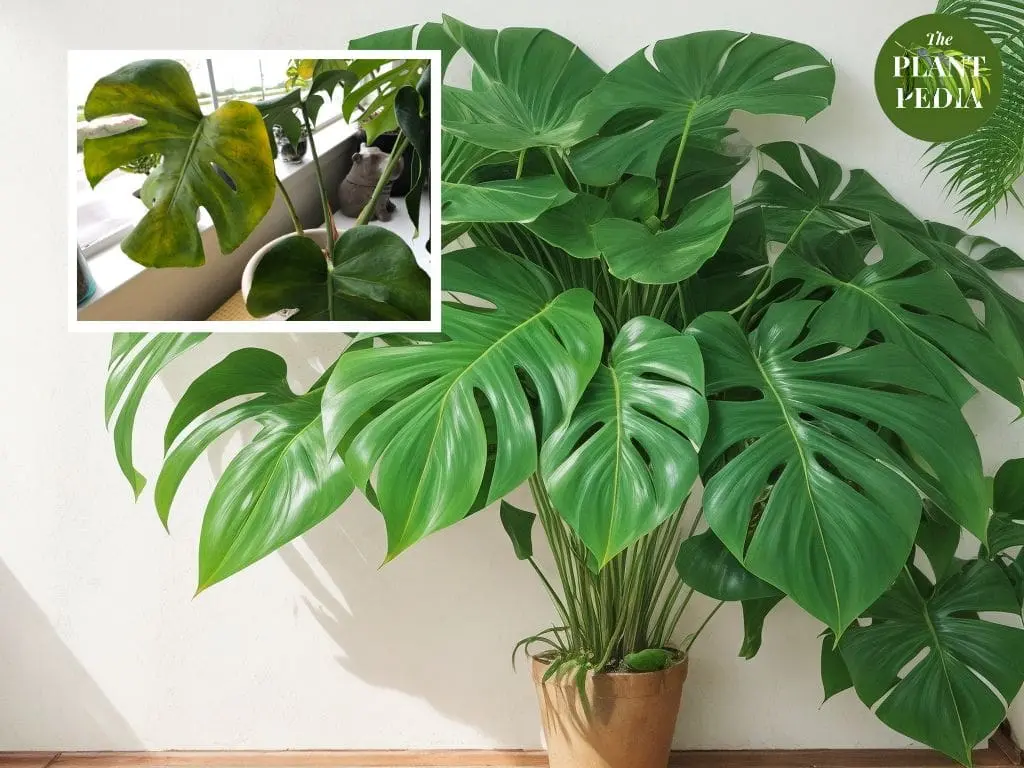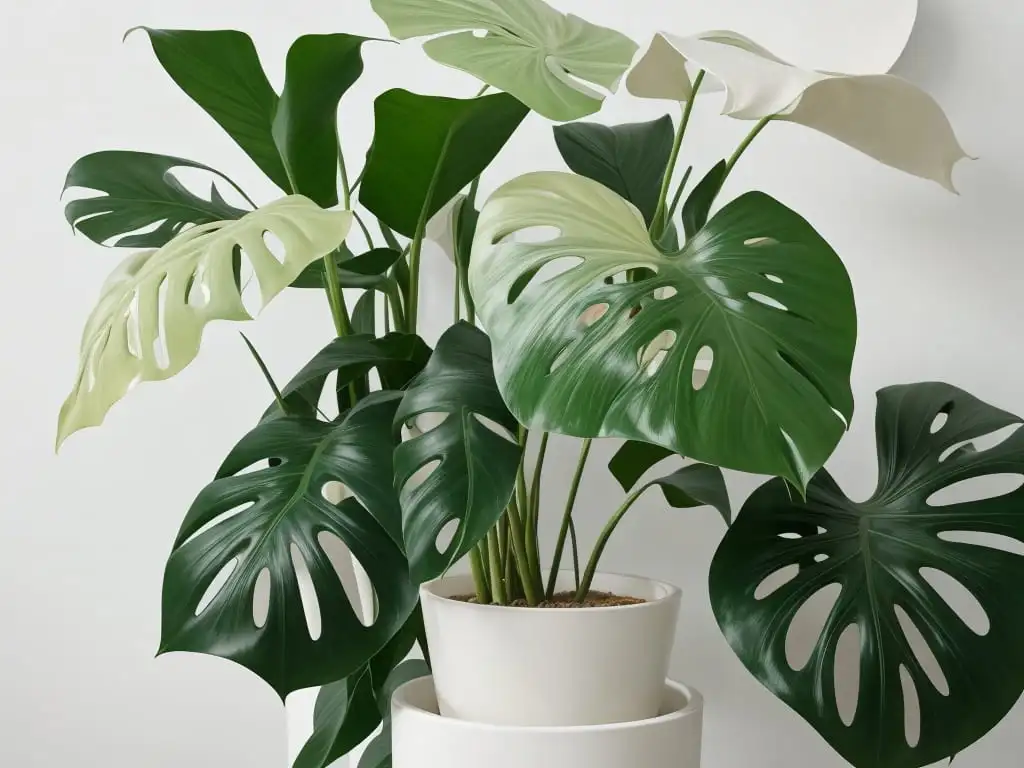Monstera deliciosa, commonly known as the Swiss cheese plant, is a popular choice among indoor plant enthusiasts for its striking foliage and relatively easy care.
However, one common issue that can perplex even experienced plant owners is when the leaves start to turn yellow.
This phenomenon can be indicative of various underlying problems, ranging from environmental stressors to nutrient deficiencies.
In this comprehensive guide, we will delve deep into the potential causes of yellowing Monstera leaves and provide detailed solutions to help your plant thrive once more.
Understanding the Anatomy of Monstera Leaves
Before we delve into the potential causes of yellowing leaves, it’s important to have a basic understanding of the anatomy of a Monstera leaf.
Monstera leaves are typically large, glossy, and deeply lobed, giving them their distinctive appearance.
They play a crucial role in the plant’s overall health and vitality, as they are responsible for photosynthesis, a process that converts light energy into chemical energy.
Read: Types of Monstera: Top Beautiful Swiss Cheese Plants.

Common Causes of Monstera Leaves Turning Yellow
Overwatering
Overwatering is a common issue that can lead to yellowing leaves in Monstera plants. When the roots are constantly submerged in water, they struggle to access oxygen, which is vital for their proper function.
This oxygen deprivation leads to root rot, a condition that hinders the plant’s ability to absorb nutrients. As a result, the leaves may begin to turn yellow.
To address overwatering, it’s crucial to allow the soil to dry out before watering again. Be sure to check the moisture level in the soil by inserting your finger about an inch deep.
If it feels dry at this depth, it’s an indication that the plant is ready for watering. Additionally, consider using a well-draining potting mix to prevent water from pooling around the roots.
Read: How Often to Water Monstera Plant?
Underwatering
Underwatering is another common cause of yellowing leaves in Monstera plants. When the soil becomes too dry, the roots are unable to uptake an adequate amount of water.
This leads to dehydration and stress, which can manifest in discolored and wilted foliage.
To combat underwatering, ensure that you water your Monstera thoroughly, allowing water to reach the entire root system.
Be cautious not to let the plant sit in standing water, as this can lead to other issues. Consider using a saucer or tray to catch excess water and empty it promptly.
Read: Monstera Leaves Curling: Symptoms, Causes, Solutions & All.
Improper Light Conditions
Proper lighting is essential for the health of a Monstera plant. Placing it in direct sunlight can result in sunburned leaves, which often appear with yellow or brown patches.
On the other hand, insufficient light can hinder the plant’s ability to carry out photosynthesis effectively, leading to yellowing leaves.
To address lighting issues, consider relocating your Monstera to a spot where it receives bright, indirect light. This mimics its natural habitat in the understory of tropical forests.
If direct sunlight is unavoidable, use sheer curtains or blinds to filter the light and protect the leaves.
Inadequate Humidity
Monstera plants thrive in high humidity environments, much like their native tropical habitats. When exposed to dry air, especially in spaces with central heating or air conditioning, the leaves may start to yellow as a sign of stress.
To combat low humidity, consider increasing moisture levels around the plant. Misting the leaves regularly can be an effective way to raise humidity, especially in drier climates.
Alternatively, use a humidifier to maintain consistent moisture levels in the air.
Nutrient Deficiencies
Yellowing leaves can often be attributed to nutrient deficiencies, particularly those of nitrogen, iron, or magnesium.
These elements are crucial for the process of photosynthesis and overall plant health. When lacking, the leaves may exhibit chlorosis, a condition characterized by a loss of green pigmentation.
To address nutrient deficiencies, consider using a balanced, water-soluble fertilizer specifically formulated for houseplants.
Follow the manufacturer’s instructions for application, being careful not to over-fertilize, which can lead to other problems. Regularly monitor the plant’s progress to ensure the issue resolves.
By identifying the specific cause of yellowing leaves and implementing targeted solutions, you can restore your Monstera plant to its full vibrancy and health.
Remember, each plant is unique, so closely observing your Monstera’s behavior and adjusting care accordingly is key to its well-being.
Read: How to Propagate Monstera: A Step-by-Step Guide.
Diagnosing the Problem
Diagnosing the issue with your Monstera is a crucial step in effectively addressing the yellowing leaves. By conducting a thorough assessment, you can pinpoint the underlying cause and implement the appropriate solutions.
Here are some key steps to follow:
Visual Inspection
Begin by carefully examining your Monstera plant from top to bottom. Look closely at the leaves, stems, and soil.
Take note of any unusual discoloration, spots, or patterns. Additionally, check for signs of pests or diseases, as these can also contribute to leaf yellowing.
Pay attention to the overall appearance of the plant. Are the leaves wilted or drooping? Is there any evidence of new growth? These visual cues can provide valuable insights into the plant’s overall health.
Checking the Soil Moisture
The moisture level of the soil is a critical factor in diagnosing leaf yellowing. Insert your finger about an inch into the soil. If it feels dry at this depth, it’s an indication that the plant may be underwater.
In contrast, if the soil feels consistently soggy, it’s likely overwatered.
Take note of any unusual odors emanating from the soil, as a foul or musty smell can be a sign of root rot, a condition often associated with overwatering.
Assessing Light Conditions
Evaluate the location where your Monstera is positioned. Consider the amount and quality of light it receives. Monstera plants thrive in bright, indirect light.
If the plant is exposed to direct sunlight for extended periods, it may develop sunburned leaves, which can manifest as yellow or brown patches.
Conversely, if the plant is in a low-light environment, it may struggle to carry out photosynthesis effectively, leading to yellowing leaves.
Examining Humidity Levels
Consider the humidity levels in your home or growing space. Monstera plants are native to tropical regions and thrive in high-humidity environments.
When exposed to dry air, especially in centrally heated or air-conditioned spaces, the leaves may start to turn yellow as a sign of stress.
Use a hygrometer to measure the humidity levels in the vicinity of your plant. If they consistently fall below the ideal range for tropical plants, it’s important to take steps to increase humidity.
By carefully assessing these key factors, you’ll be better equipped to determine the specific cause of your Monstera’s leaf yellowing.
This targeted approach will enable you to implement the most effective solutions for restoring your plant’s health and vitality. Remember, patience and close observation are essential in the diagnosis process.

Read: Albino Monstera: Care, Propagation, Challenges, & All.
Addressing the Issue
Once you’ve identified the potential causes of your Monstera’s leaf yellowing, it’s time to take action. Addressing the issue promptly and effectively is crucial for restoring your plant’s health and vitality.
Here are specific steps you can take for each identified problem:
Adjusting Watering Practices
Overwatering:
If overwatering is identified as the cause of leaf yellowing, it’s imperative to adjust your watering routine. Allow the soil to dry out before watering again. This will give the roots an opportunity to recover and prevent further damage.
Ensure that your Monstera’s pot has proper drainage holes to allow excess water to escape. Consider repotting if the current container doesn’t facilitate proper drainage.
Underwatering:
To combat underwatering, make sure you water your Monstera thoroughly, allowing water to reach the entire root system. Be cautious not to let the plant sit in standing water, as this can lead to other issues.
Consider using a saucer or tray to catch excess water and empty it promptly.
Optimizing Light Conditions
Excessive Light:
If your Monstera is exposed to direct sunlight for extended periods, consider relocating it to a spot with bright, indirect light. Sheer curtains or blinds can be used to filter the light and protect the leaves from potential sunburn.
Insufficient Light:
If your plant is not receiving enough light, consider moving it to a location with better illumination. Providing bright, indirect light mimics the conditions of its natural habitat in tropical forests.
Increasing Humidity
Low Humidity:
To combat low humidity, consider increasing moisture levels around the plant. Misting the leaves regularly can be an effective way to raise humidity, especially in drier climates. Alternatively, use a humidifier to maintain consistent moisture levels in the air.
Addressing Nutrient Deficiencies
If a nutrient deficiency is suspected, it’s important to address it promptly to prevent further leaf yellowing and promote healthy growth.
Consider using a balanced, water-soluble fertilizer specifically formulated for houseplants. Follow the manufacturer’s instructions for application, being careful not to over-fertilize, which can lead to other problems. Monitor the plant’s progress to ensure that the issue resolves.
Related FAQs:
Why are my Monstera leaves turning yellow?
There are several potential reasons for Monstera leaves turning yellow. Common causes include overwatering, underwatering, improper light conditions, inadequate humidity levels, and nutrient deficiencies.
Each of these factors can contribute to stress on the plant, resulting in yellowing foliage.
How can I differentiate between overwatering and underwatering as the cause of yellow leaves?
Overwatering typically leads to waterlogged soil and roots, causing them to rot. In contrast, underwatering results in dry, parched soil and dehydrated roots. To diagnose the issue, check the moisture level of the soil about an inch deep.
If it’s consistently soggy, overwatering may be the problem. If it’s dry, underwatering is more likely.
Can low humidity be a factor in Monstera leaf yellowing?
Yes, low humidity can contribute to Monstera leaf yellowing. These plants are native to tropical regions and thrive in high humidity environments.
When exposed to dry air, especially in centrally heated or air-conditioned spaces, Monstera leaves may turn yellow as a sign of stress.
How can I increase humidity around my Monstera plant?
There are several ways to increase humidity for your Monstera:
- Misting: Regularly misting the leaves with water can help raise humidity levels.
- Humidifier: Using a humidifier in the vicinity of your plant can maintain consistent moisture in the air.
- Water Tray: Placing the plant’s pot on a tray filled with water and pebbles can create a localized humid microclimate.
What should I do if I suspect a nutrient deficiency is causing leaf yellowing?
If you suspect a nutrient deficiency, consider using a balanced, water-soluble fertilizer designed for houseplants.
Look for a formulation that addresses common deficiencies like nitrogen, iron, and magnesium. Follow the manufacturer’s instructions for application and monitor the plant’s progress to ensure improvement.
Is it normal for older leaves to turn yellow and fall off?
Yes, it’s normal for older leaves to turn yellow and eventually drop off. This is a natural part of a plant’s growth cycle.
However, if you notice excessive yellowing and leaf drop, especially among younger leaves, it may indicate an underlying issue that needs attention.
Can repotting help if overwatering is the issue?
Yes, repotting can be beneficial if overwatering has led to root rot. Choose a well-draining potting mix and ensure the new pot has adequate drainage holes.
Gently remove the plant from its current pot, trim away any damaged roots, and replant it in the fresh soil. Be sure to adjust your watering practices to prevent overwatering in the future.
Can Monstera leaves recover once they’ve turned yellow?
In many cases, yes, Monstera leaves can recover once they’ve turned yellow. Addressing the underlying issue, whether it’s overwatering, underwatering, or another factor, is crucial. With the right care and adjustments, you may see new healthy growth emerge.
However, it’s important to note that severely damaged leaves may not fully return to their original state and may eventually fall off.
How often should I fertilize my Monstera to prevent nutrient deficiencies?
The frequency of fertilizing your Monstera depends on the type of fertilizer you’re using. Generally, a balanced, water-soluble fertilizer should be applied every 4-6 weeks during the growing season (spring and summer).
During the dormant season (fall and winter), you can reduce or suspend fertilizing, as the plant’s growth slows down.
Are there specific signs I should look for to determine if my Monstera has a pest infestation?
Yes, there are several signs that may indicate a pest infestation on your Monstera:
- Visible Insects: Look closely at the leaves, stems, and soil for any signs of pests such as aphids, spider mites, or mealybugs.
- Sticky Residue: Sticky or shiny residue on the leaves (known as honeydew) can be a sign of aphids or other sap-sucking insects.
- Wilting or Distorted Leaves: Damage to the leaves, including wilting or distortion, can be caused by feeding pests.
- Webbing or Silk: Spider mites often leave fine webbing on the undersides of leaves.
Can I use natural remedies to control pests on my Monstera?
Yes, there are natural remedies that can be effective in controlling pests on your Monstera:
- Neem Oil: Neem oil is a natural insecticide that can help control a variety of pests. Mix it with water and apply it to the plant.
- Insecticidal Soap: A mild insecticidal soap can be effective against soft-bodied pests like aphids, mites, and mealybugs.
- Diatomaceous Earth: This natural powder, made from fossilized algae, can be sprinkled on the soil to deter crawling insects.
Should I prune yellowed leaves from my Monstera?
Yes, it’s generally a good idea to prune yellowed leaves from your Monstera. These leaves are no longer contributing to the plant’s health and removing them can redirect energy towards new growth.
Use clean, sharp scissors or pruning shears to make clean cuts near the base of the leaf stem.
Remember to sterilize your cutting tools before and after pruning to prevent the spread of any potential pathogens.
How long does it typically take for a Monstera to recover from leaf yellowing?
The recovery time for a Monstera with yellowed leaves can vary depending on the severity of the issue, the overall health of the plant, and the effectiveness of the corrective measures taken.
In some cases, you may start to see signs of improvement within a few weeks, while in more severe cases, it may take several months for the plant to fully rebound.
Conclusion
Yellowing leaves on a Monstera plant can be a cause for concern, but with careful diagnosis and appropriate action, it’s often possible to revive the plant’s health and vitality.
By understanding the potential causes and implementing the suggested solutions, you can enjoy a thriving and lush Monstera in your indoor garden once more.
Remember, patience and attentiveness are key when it comes to caring for your beloved Swiss cheese plant.
